Search Result
Results for "
signal peptide
" in MedChemExpress (MCE) Product Catalog:
| Cat. No. |
Product Name |
Target |
Research Areas |
Chemical Structure |
-
- HY-P2522
-
|
|
Bacterial
|
Infection
|
|
Competence-Stimulating Peptide-2 (CSP-2) is a quorum sensing signal peptide produced by Streptococcus pneumoniae. ComD2 is a compatible receptor of Competence-Stimulating Peptide-2 (CSP-2) with an EC50 value of 50.7 nM .
|
-

-
- HY-111360
-
|
|
γ-secretase
|
Inflammation/Immunology
|
|
SPL-707 is an orally active, selective signal peptide peptidase-like 2a (SPPL2a) inhibitor with an IC50 of 77 nM for hSPPL2a. SPL-707 inhibits γ-secretase (IC50=6.1 μM) and SPP (IC50=3.7 μM). SPL-707 has the potential for autoimmune diseases research by targeting B cells and dendritic cells .
|
-

-
- HY-103473A
-
|
Boc-Met-Leu-Phe-OH TFA
|
Formyl Peptide Receptor (FPR)
|
Inflammation/Immunology
|
|
Boc-MLF (TFA) is a peptide, used as a specific formyl peptide receptor (FPR) antagonist, also inhibits the signaling through formyl peptide receptor like 1 (FPRL1) at higher concentrations .
|
-
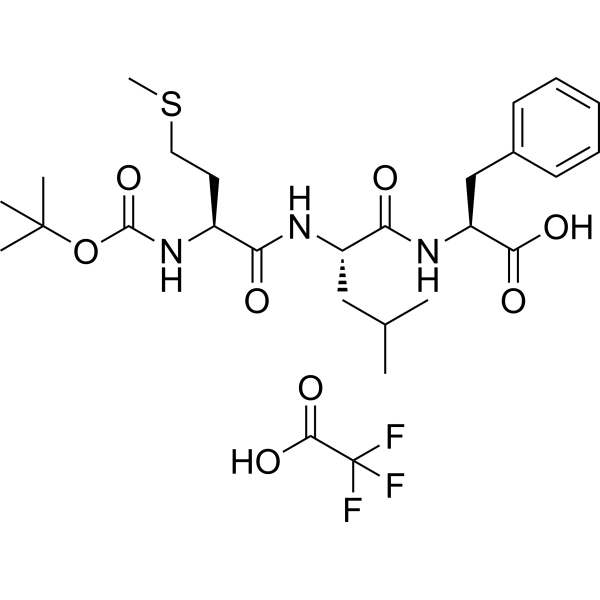
-
- HY-P4858
-
|
|
GSK-3
|
Cancer
|
|
C-Peptide 1 (rat), a peptide, is aβ-catenin/GSK-3β activator. C-Peptide 1 (rat) can regulate the Wnt/β-catenin signaling pathway. C-Peptide 1 (rat) can be used for the research of cancer .
|
-

-
- HY-P3496
-
|
|
Pyroptosis
|
Inflammation/Immunology
|
|
Pep19-2.5 is an synthetic and antitoxin peptide, blocks the intracellular endotoxin signaling cascade. Pep19-2.5 inhibits signaling of lipopeptides (LP) and lipopolysaccharides (LPS) mediated by transmembrane and cytosolic pattern recognition receptors (PRRs). The signaling cascades lead to inflammation and cell pyroptosis .
|
-

-
- HY-P1111
-
|
|
Src
Interleukin Related
|
Inflammation/Immunology
|
|
Lyn peptide inhibitor is a potent and cell-permeable inhibitor of Lyn-coupled IL-5 receptor signaling pathway, while keeping other signals intact. Lyn peptide inhibitor blocks Lyn activation and inhibits the binding of Lyn tyrosine kinase to βc subunit of IL-3/GM-CSF/IL-5 receptors. Lyn peptide inhibitor can be used for study of asthma, allergic, and other eosinophilic disorders .
|
-

-
- HY-P1111A
-
|
|
Src
Interleukin Related
|
Inflammation/Immunology
|
|
Lyn peptide inhibitor TFA is a potent and cell-permeable inhibitor of Lyn-coupled IL-5 receptor signaling pathway, while keeping other signals intact. Lyn peptide inhibitor TFA blocks Lyn activation and inhibits the binding of Lyn tyrosine kinase to βc subunit of IL-3/GM-CSF/IL-5 receptors. Lyn peptide inhibitor TFA can be used for study of asthma, allergic, and other eosinophilic disorders .
|
-

-
- HY-P0250
-
-

-
- HY-P3657A
-
|
|
Fluorescent Dye
|
Cancer
|
|
Biotin-KKKRKV acetate is the biotinylated KKKRKV acetate. KKKRKV is a nuclear localization signal (NLS) peptide derived from simian virus 40 .
|
-

-
- HY-P10164
-
|
|
Wnt
|
Cancer
|
|
Pen-N3 is a PDZ peptide. Pen-N3 inhibits Wnt/b-catenin signaling by recognizing dishevelled protein .
|
-

-
- HY-P1556
-
|
|
PKG
|
Cardiovascular Disease
|
|
Vasonatrin Peptide (VNP) is a chimera of atrial natriuretic peptide (ANP) and C-type natriuretic peptide (CNP). Vasonatrin peptide possesses the venodilating actions of CNP, the natriuretic actions of ANP, and unique arterial vasodilating actions not associated with either ANP or CNP. Vasonatrin Peptide protects the diabetic heart against ischemia-reperfusion injury by inhibiting ER stress via the cGMP-PKG signaling pathway .
|
-
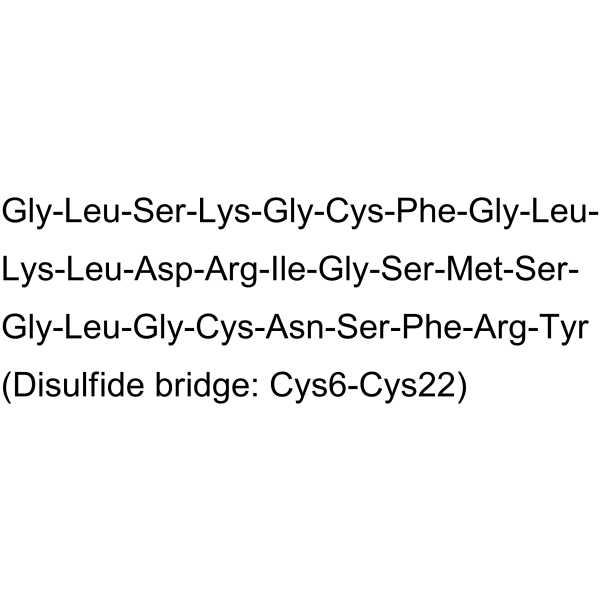
-
- HY-P1556A
-
|
|
PKG
|
Metabolic Disease
|
|
Vasonatrin Peptide (VNP) TFA is a chimera of atrial natriuretic peptide (ANP) and C-type natriuretic peptide (CNP). Vasonatrin peptide TFA possesses the venodilating actions of CNP, the natriuretic actions of ANP, and unique arterial vasodilating actions not associated with either ANP or CNP. Vasonatrin Peptide TFA protects the diabetic heart against ischemia-reperfusion injury by inhibiting ER stress via the cGMP-PKG signaling pathway .
|
-

-
- HY-P2565
-
-

-
- HY-128356
-
|
|
Others
|
Inflammation/Immunology
|
|
SPL-410 is an orally active, highly potent and selective hydroxyethylamine based SPPL2a (Signal Peptide Peptidase Like 2a) inhibitor, with an IC50 of 9 nM .
|
-
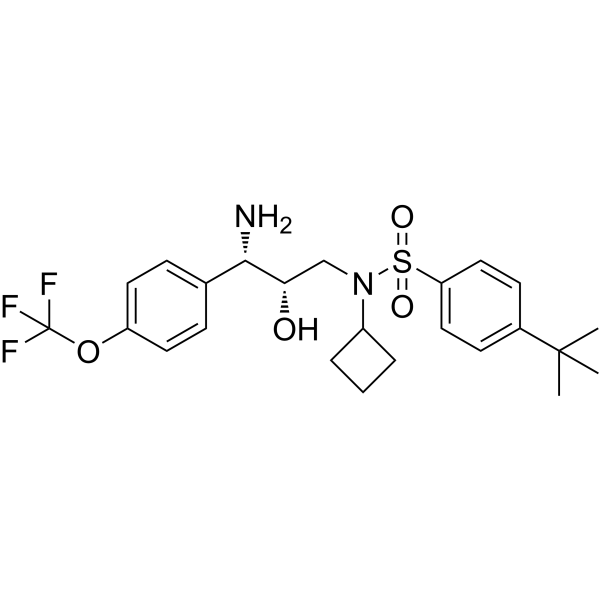
-
- HY-107024
-
|
OGP(10-14); Historphin
|
Src
|
Others
|
|
Osteogenic Growth Peptide (10-14) (OGP(10-14)), the C-terminal truncated pentapeptide of osteogenic growth peptide (OGP), retains the full OGP-like activity. Osteogenic Growth Peptide (10-14) is responsible for the binding to the OGP receptor and activates an intracellular Gi-protein-MAP kinase signaling pathway. Osteogenic Growth Peptide (10-14) is a potent mitogen and stimulator of osteogenesis and hematopoiesis. Osteogenic Growth Peptide (10-14) acts as a Src inhibitor .
|
-
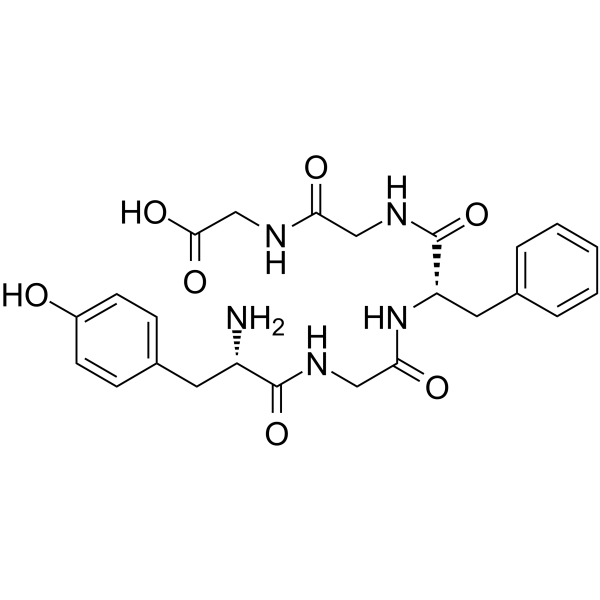
-
- HY-P0142
-
|
|
Guanylate Cyclase
|
Inflammation/Immunology
|
|
DT-3 is a membrane-permeable protein kinase G Iα inhibitory peptide. DT-3 is a guanylyl cyclase? inhibitor and shows pharmacological blockade of the cGMP–PKG signalling .
|
-

-
- HY-P1868
-
|
DGEA peptide
|
Integrin
|
Infection
|
|
α2β1 Integrin Ligand Peptide interacts with the α2β1 integrin receptor on the cell membrane and mediates extracellular signals into cells. It is a potential antagonist of collagen receptors .
|
-
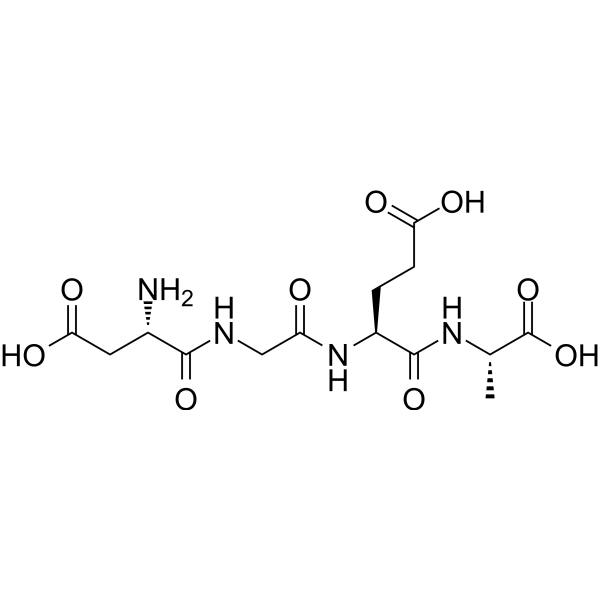
-
- HY-P1868A
-
|
DGEA peptide TFA
|
Integrin
|
Others
|
|
α2β1 Integrin Ligand Peptide TFA interacts with the α2β1 integrin receptor on the cell membrane and mediates extracellular signals into cells. It is a potential antagonist of collagen receptors .
|
-

-
- HY-P5358
-
|
|
Protease Activated Receptor (PAR)
|
Others
|
|
YFLLRNP is a biological active peptide. (a partial agonist of PAR-1. YFLLRNP selectively active G12/13 signaling pathway without activating Gq or Gi pathways at low concentrations. YFLLRNP (60 μM))
|
-
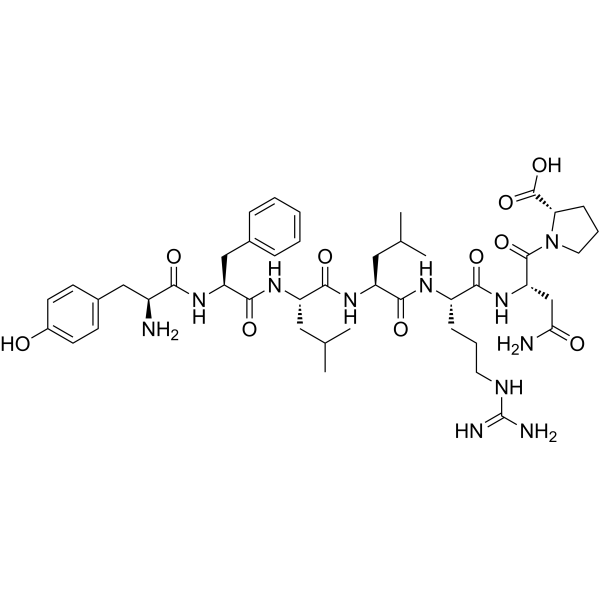
-
- HY-P2230
-
|
A6 peptide
|
PAI-1
|
Cancer
|
|
Angstrom6 (A6 Peptide) is an 8 amino-acid peptide derived from single-chain urokinase plasminogen activator (scuPA) and interferes with the uPA/uPAR cascade and abrogates downstream effects. Angstrom6 binds to CD44 resulting in the inhibition of migration, invasion, and metastasis of tumor cells, and the modulation of CD44-mediated cell signaling .
|
-
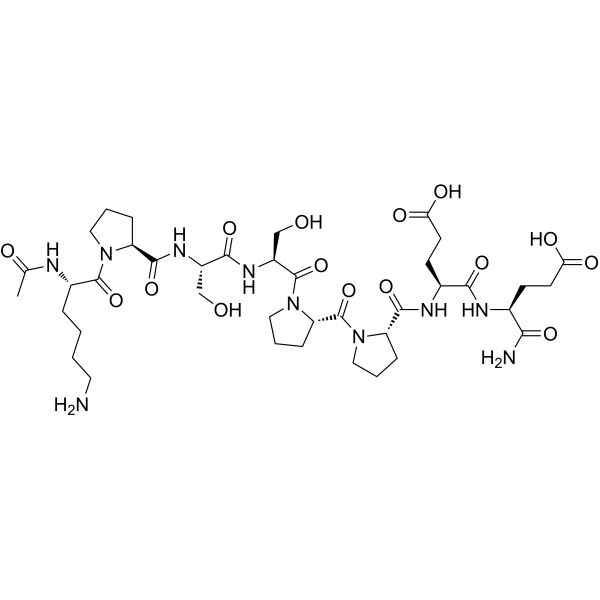
-
- HY-P1453
-
|
|
STAT
|
Cancer
|
|
CMD178 is a lead peptide that consistently reduced the expression of Foxp3 and STAT5 induced by IL-2/s IL-2Rα signaling and inhibits Treg cell development .
|
-

-
- HY-P1453A
-
|
|
STAT
|
Cancer
|
|
CMD178 TFA is a lead peptide that consistently reduced the expression of Foxp3 and STAT5 induced by IL-2/s IL-2Rα signaling and inhibits Treg cell development .
|
-
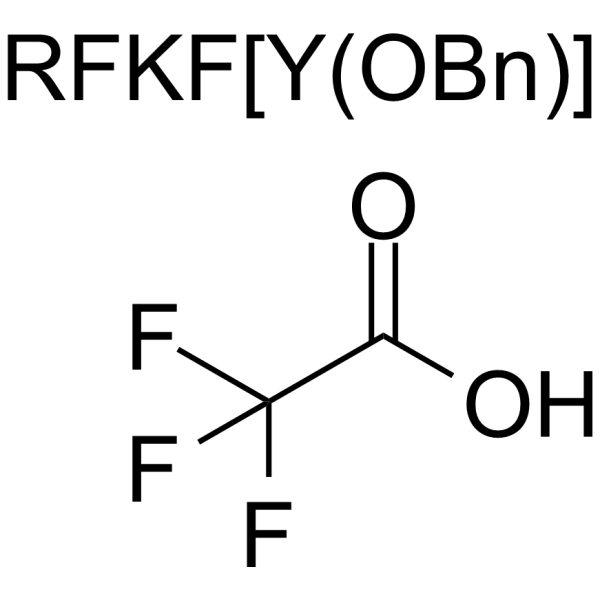
-
- HY-P1396
-
-

-
- HY-10805
-
|
ACT 078573
|
Orexin Receptor (OX Receptor)
Calcium Channel
Caspase
Apoptosis
|
Neurological Disease
Endocrinology
Cancer
|
|
Almorexant (ACT 078573) is an orally active, potent and competitive dual orexin receptor antagonist, with Kd values of 1.3 nM (OX1) and 0.17 nM (OX2), respectively. Almorexant reversibly blocks signaling of orexin-A and orexin-B peptides. Almorexant totally blocked the intracellular Ca 2+ signal pathway. Almorexant stimulates caspase-3 activity in AsPC-1 cells and induces apoptosis .
|
-

-
- HY-10805A
-
|
ACT 078573 hydrochloride
|
Orexin Receptor (OX Receptor)
Calcium Channel
Caspase
Apoptosis
|
Neurological Disease
Endocrinology
Cancer
|
|
Almorexant (ACT 078573) hydrochloride is an orally active, potent and competitive dual orexin receptor antagonist, with Kd values of 1.3 nM (OX1) and 0.17 nM (OX2), respectively. Almorexant hydrochloride reversibly blocks signaling of orexin-A and orexin-B peptides. Almorexant hydrochloride totally blocked the intracellular Ca 2+ signal pathway. Almorexant hydrochloride stimulates caspase-3 activity in AsPC-1 cells and induces apoptosis .
|
-

-
- HY-P10090
-
|
|
Akt
PI3K
Apoptosis
|
Cancer
|
|
Apoptin-derived peptide is an antitumor polypeptide with cytotoxicity. Apoptin-derived peptide promotes apoptosis and necrosis of gastric cancer (GC) cells by regulating PI3K/AKT/ARNT signaling. Apoptin-derived peptide inhibited the invasion and migration of cancer cells, and inhibited the expression and phosphorylation of the subunit p85 of PI3K, which further inhibited the PI3K/AKT pathway involved in the development of gastric cancer .
|
-

-
- HY-106275
-
|
Fibrin-derived peptide Bβ15-42
|
Flavivirus
Dengue virus
|
Cardiovascular Disease
|
|
FX-06 (Fibrin-derived peptide Bβ15-42) is a fibrin Bbeta chain-derived peptide. FX-06 binds to VE-cadherin and inhibits leukocyte transmigration and initiates VE-cadherin-mediated signaling. FX-06 can be used in the research of ischemia/reperfusion injury, Dengue shock syndrome (DSS) .
|
-

-
- HY-P2282
-
|
|
STAT
|
Cancer
|
|
APTSTAT3-9R, a specific STAT3-binding peptide, inhibits STAT3 activation and downstream signaling by specifically blocking STAT3 phosphorylation. APTSTAT3-9R exerts antiproliferative effects and antitumor activity .
|
-
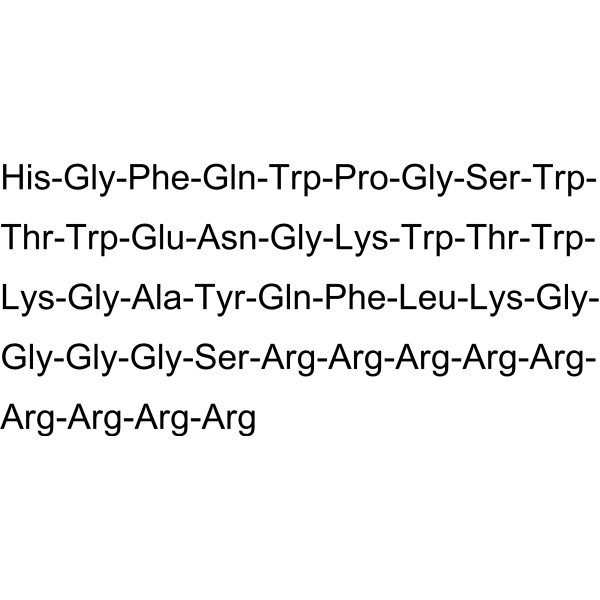
-
- HY-P2272
-
|
|
Wnt
β-catenin
|
Cancer
|
|
NLS-StAx-h is a selective, cell permeable, stapled peptide Wnt signaling inhibitor with an IC50 of 1.4 μM. NLS-StAx-h efficiently inhibits β-catenin-transcription factor interactions. NLS-StAx-h shows anti-proliferation of cancer cells .
|
-
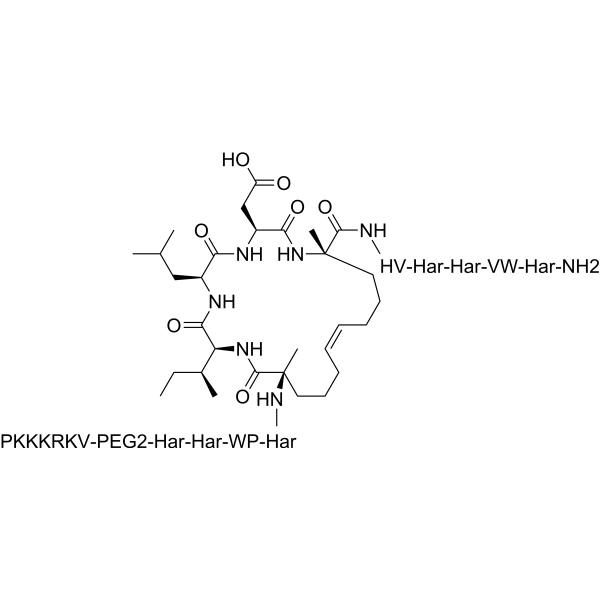
-
- HY-P1420
-
|
|
HIF/HIF Prolyl-Hydroxylase
|
Cancer
|
|
TAT-cyclo-CLLFVY is a cyclic peptide inhibitor of HIF-1 heterodimerization that inhibits hypoxia signaling in cancer cells. TAT-cyclo-CLLFVY disrupts HIF-1α/HIF-1β protein-protein interaction with an IC50 of 1.3 μM .
|
-

-
- HY-134809
-
|
CADA
|
HIV
|
Infection
Inflammation/Immunology
|
|
Cyclotriazadisulfonamide (CADA) is a specific CD4-targeted HIV entry inhibitors. Cyclotriazadisulfonamide (CADA) inhibits the co-translational translocation of human CD4 (huCD4) into the ER lumen in a signal peptide (SP)-dependent way. Cyclotriazadisulfonamide is also a Sec61 translocon inhibitor .
|
-

-
- HY-P3970
-
|
|
TGF-β Receptor
|
Inflammation/Immunology
|
|
KRFK, a peptide derived from TSP-1, can activate TGF-β. KRFK promotes TGF-β-mediated signaling and its downstream role, independent of thrombospondin (TSP) receptors such as CD47 and CD36. KRFK can be used for chronic ocular surface inflammatory disorders reseach .
|
-
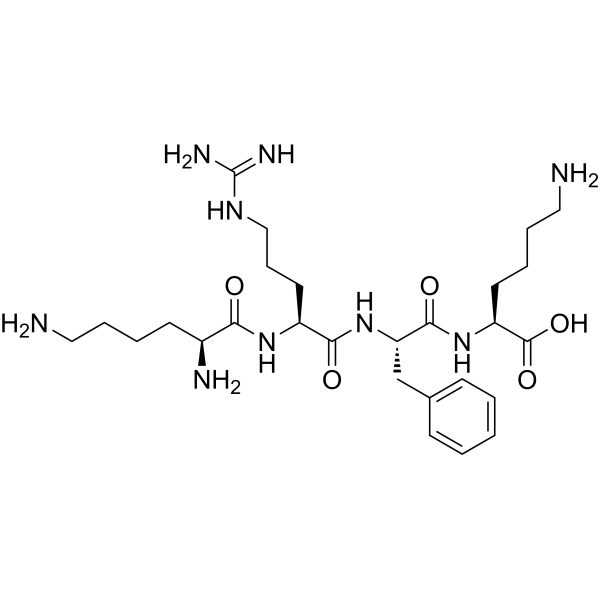
-
- HY-P1420A
-
|
|
HIF/HIF Prolyl-Hydroxylase
|
Cancer
|
|
TAT-cyclo-CLLFVY TFA is a cyclic peptide inhibitor of HIF-1 heterodimerization that inhibits hypoxia signaling in cancer cells. TAT-cyclo-CLLFVY TFA disrupts HIF-1α/HIF-1β protein-protein interaction with an IC50 of 1.3 μM .
|
-

-
- HY-P2272A
-
|
|
Wnt
β-catenin
|
Cancer
|
|
NLS-StAx-h TFA is a selective, cell permeable, stapled peptide Wnt signaling inhibitor with an IC50 of 1.4 μM. NLS-StAx-h TFA efficiently inhibits β-catenin-transcription factor interactions. NLS-StAx-h TFA shows anti-proliferation of cancer cells .
|
-
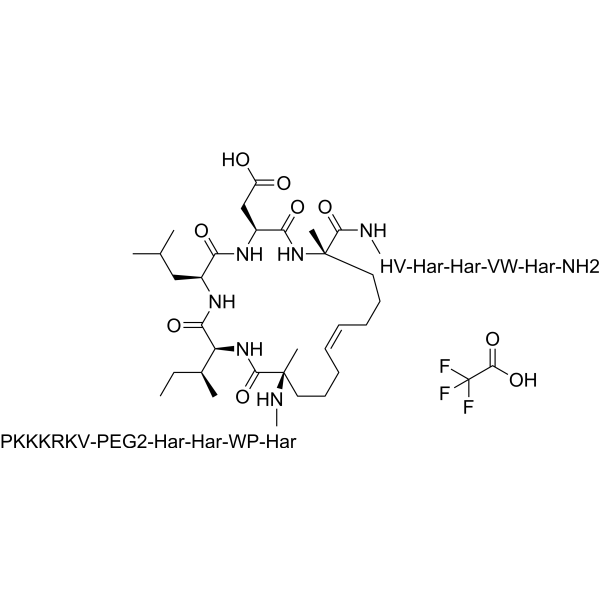
-
- HY-P3970A
-
|
|
TGF-β Receptor
|
Inflammation/Immunology
|
|
KRFK TFA, a peptide derived from TSP-1, can activate TGF-β. KRFK TFA promotes TGF-β-mediated signaling and its downstream role, independent of thrombospondin (TSP) receptors such as CD47 and CD36. KRFK TFA can be used for chronic ocular surface inflammatory disorders reseach .
|
-
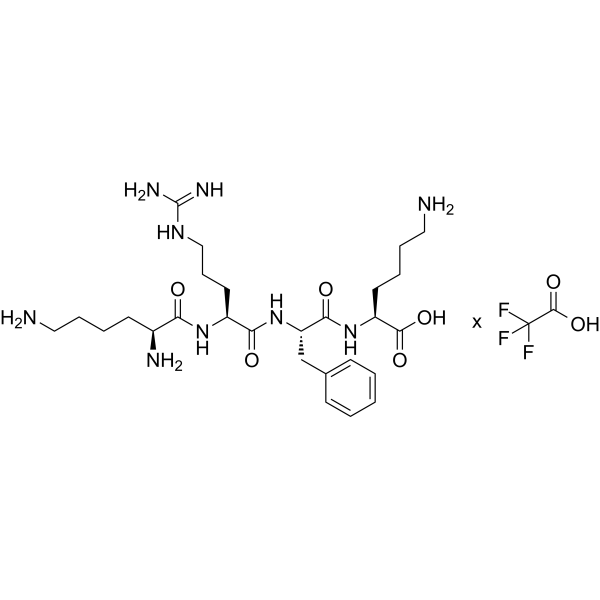
-
- HY-120006A
-
|
|
ERK
|
Cardiovascular Disease
|
|
(rel)-AR234960 is an active relative configuration of AR234960. AR234960, a non-peptide MAS (a G protein-coupled receptor) agonist, increases both mRNA and protein levels of CTGF via ERK1/2 signaling in HEK293-MAS cells and adult human cardiac fibroblasts .
|
-

-
- HY-113469A
-
|
|
Endogenous Metabolite
|
Inflammation/Immunology
|
|
Cyclic GMP sodium (cGMP) is an important regulator of short-term changes in smooth muscle tone and longer-term responses to chronic drug research or proliferative signals, it is in response to atrial natriuretic peptide (ANP) or nitric oxide (NO). Cyclic GMP sodium interacts with cation channels to regulate ion transport or activate the cyclic GMP-dependent protein kinase to result in protein phosphorylation .
|
-
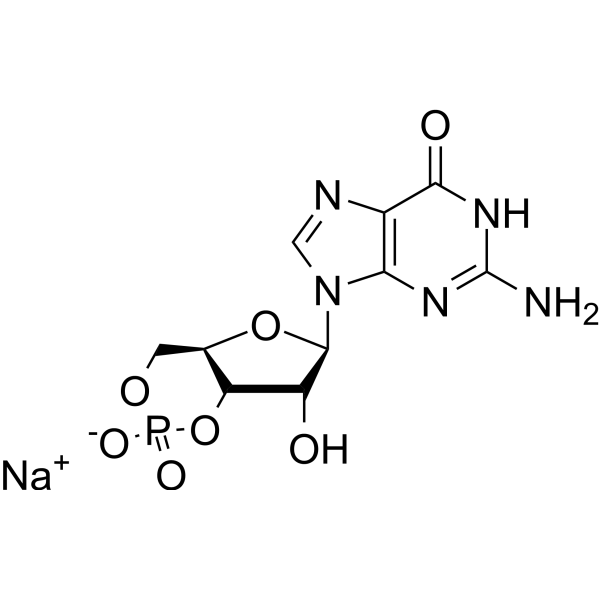
-
- HY-P1812
-
|
NP-12
|
PD-1/PD-L1
|
Cancer
|
|
AUNP-12 (NP-12) is a peptide antagonist of the PD-1 signaling pathway, displays equipotent antagonism toward PD-L1 and PD-L2 in rescue of lymphocyte proliferation and effector functions. AUNP-12 exhibits immune activation, excellent antitumor activity, and potential for better management of immune-related adverse events (irAEs) .
|
-
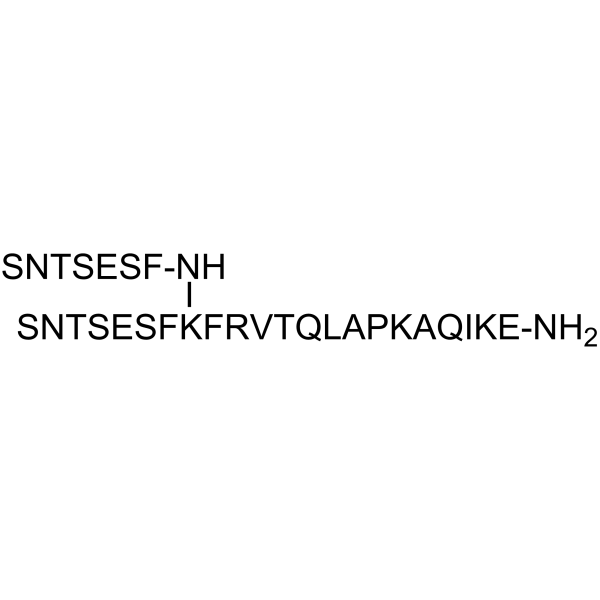
-
- HY-P3828
-
|
|
Fluorescent Dye
|
Neurological Disease
|
|
Biotin-myelin basic protein (94-102) is a peptide fragemt. Myelin basic protein is responsible for adhesion of the cytosolic surfaces of multilayered compact myelin, it plays an important role in the process of myelination of nerves in the nervous system. Myelin basic protein also acts as a membrane actin-binding protein, which might allow it to participate in transmission of extracellular signals to the cytoskeleton in oligodendrocytes and tight junctions in myelin .
|
-
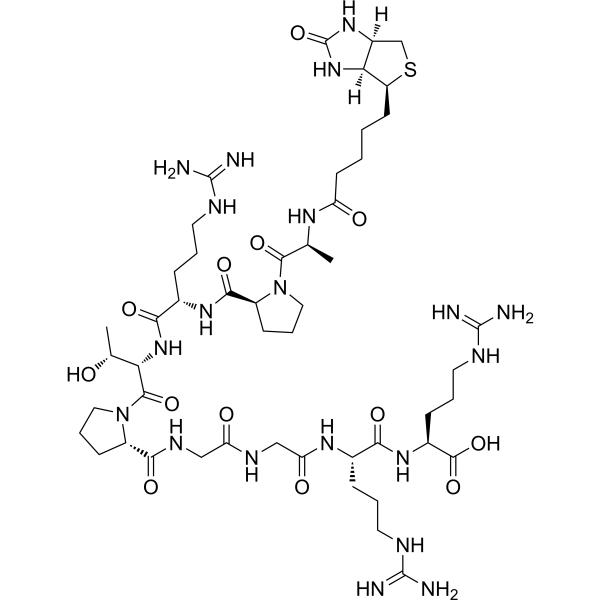
-
- HY-P3971
-
|
|
TGF-beta/Smad
|
Inflammation/Immunology
|
|
H-Leu-Ser-Lys-Leu-OH (LSYL) is a latency-associated peptide at the amino terminus of LAP, with inhibitory effect on TGF-β1 activation. H-Leu-Ser-Lys-Leu-OH, binding with KRFK (HY-P3970), can block the signal transduction of TGF-β1, and prevent the progression of hepatic damage and fibrosis .
|
-
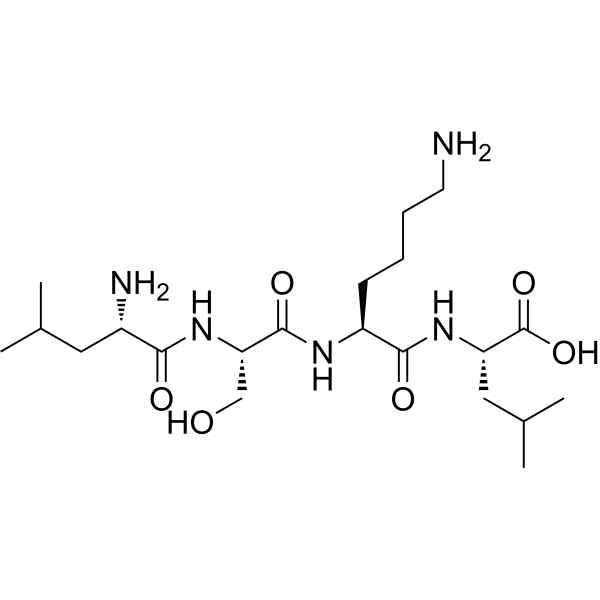
-
- HY-P1812A
-
|
NP-12 TFA
|
PD-1/PD-L1
|
Cancer
|
|
AUNP-12 TFA (NP-12 TFA) is a peptide antagonist of the PD-1 signaling pathway, displays equipotent antagonism toward PD-L1 and PD-L2 in rescue of lymphocyte proliferation and effector functions. AUNP-12 TFA exhibits immune activation, excellent antitumor activity, and potential for better management of immune-related adverse events (irAEs) .
|
-
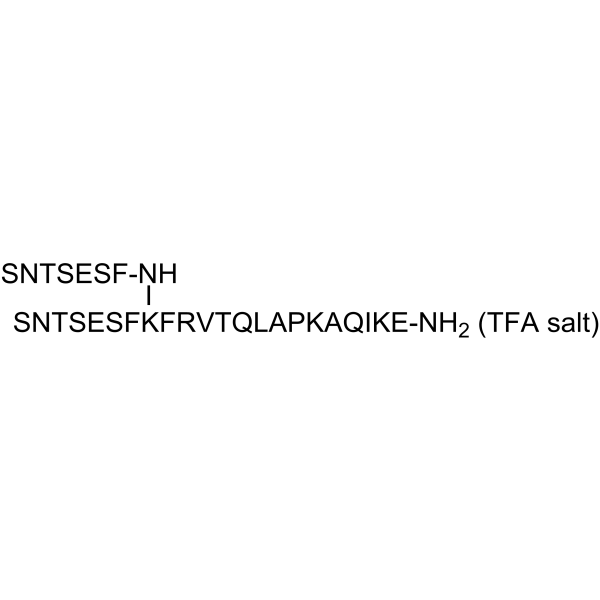
-
- HY-P5372
-
|
|
Protease Activated Receptor (PAR)
|
Others
|
|
Ala-parafluoroPhe-Arg-Cha-Cit-Tyr-NH2 is a biological active peptide. (Protease activated receptor 1 (PAR-1) belongs to a subfamily of G-protein coupled receptors and is known to mediate the cellular effects of thrombin. This peptide is a PAR-1 selective agonist displaying a high level of specificity to PAR-1 over PAR-2. The specificity of peptide was evaluated in cell-based calcium signaling assay using HEK293 cells. PAR-1 selective agonists can be used to study PAR-1 activation in vivo. In addition to its varied cellular effects of thrombin, PAR-1 has also been shown to coordinate with PAR-4 and regulate thrombin-induced hepatocellular carcinoma harboring thrombin formation within the tumor environment classified as 'coagulation type'.)
|
-

-
- HY-P1135
-
|
|
Neuropeptide Y Receptor
|
Neurological Disease
|
|
M1145, a chimeric peptide, is a selective galanin receptor type 2 (GAL2) agonist, with a Ki of 6.55 nM. M1145 shows more than 90-fold higher affinity for GAL2 over GAL1 (Ki=587 nM) and a 76-fold higher affinity over GalR3 (Ki=497 nM). M1145 has an additive effect on the signal transduction of galanin .
|
-

-
- HY-P1135A
-
|
|
Neuropeptide Y Receptor
|
Neurological Disease
|
|
M1145 TFA, a chimeric peptide, is a selective galanin receptor type 2 (GAL2) agonist, with a Ki of 6.55 nM. M1145 TFA shows more than 90-fold higher affinity for GAL2 over GAL1 (Ki=587 nM) and a 76-fold higher affinity over GalR3 (Ki=497 nM). M1145 TFA has an additive effect on the signal transduction of galanin .
|
-

-
- HY-155077
-
|
|
JNK
|
Cancer
|
|
JNK-IN-12 (compound P2) is a mitochondrial-targeted JNK inhibitor (IC50=66.3 nM), consisting of a mitochondrial-specific cell-penetrating peptide and a specific inhibitor of JNK, SP600125 (HY-12041). JNK-IN-12 doesn't inhibit nuclear JNK signaling, but does inhibit mitochondrial JNK phosphorylation. JNK-IN-12 helps to improve the Parkinson's disease (PD) both in vitro and in vivo .
|
-
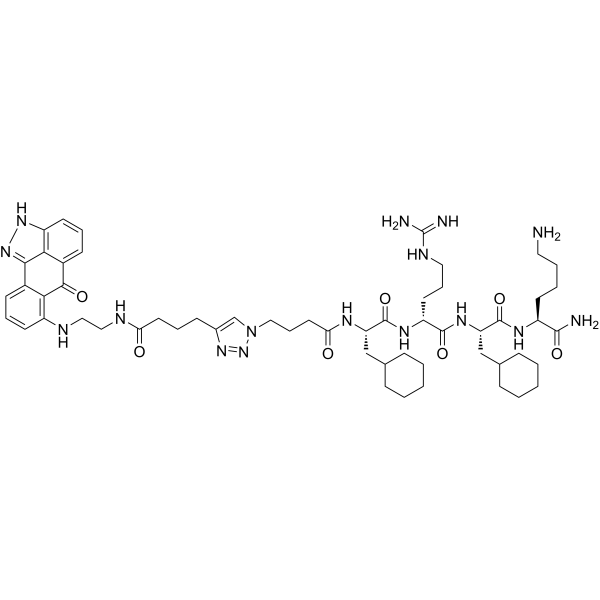
-
- HY-P1416
-
|
|
Wnt
|
Cancer
|
|
Foxy-5, a WNT5A agonist, is a mimicking peptide of WNT5A which is a non-canonical member of the Wnt family. Foxy-5 triggers cytosolic free calcium signaling without affecting β-catenin activation and it impairs the migration and invasion of epithelial cancer cells. Foxy-5 effectively reduces the metastatic spread of WNT5A-low prostate cancer cells in an orthotopic mouse model .
|
-
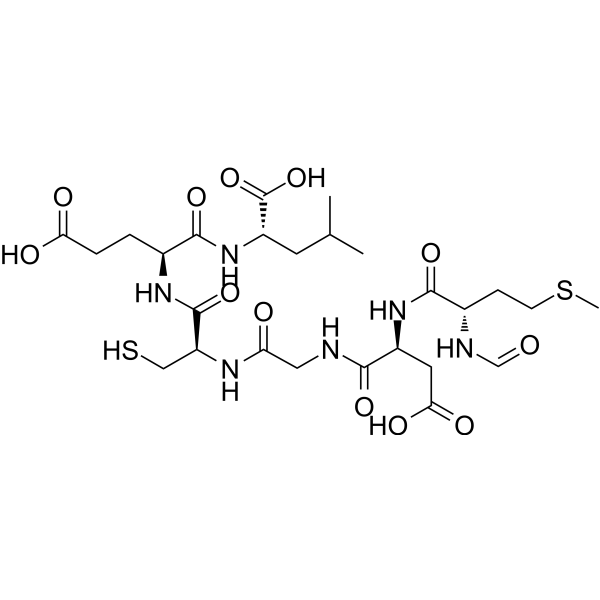
-
- HY-P1454
-
Fz7-21
3 Publications Verification
Ac-LPSDDLEFWCHVMY-NH2
|
Wnt
|
Cancer
|
|
Fz7-21 (Ac-LPSDDLEFWCHVMY-NH2) is a potent peptide antagonist of FZD7 receptors , selectively binds to FZD7 CRD subclass and alters the conformation of the CRD and the architecture of its lipid-binding groove. The EC50 values are 58 and 34 nM for human and mouse FZD7 CRD, respectively. Fz7-21 impairs the function of FZD7 in Wnt–β-catenin signalling and stem cell function in intestinal organoids .
|
-

-
- HY-14743B
-
|
SCV 07 hydrochloride; Gamma-D-glutamyl-L-tryptophan hydrochloride
|
Bacterial
STAT
|
Infection
Inflammation/Immunology
Cancer
|
|
Golotimod hydrochloride (SCV 07 hydrochloride), an immunomodulating peptide with antimicrobial activity, significantly increases the efficacy of antituberculosis therapy, stimulates thymic and splenic cell proliferation, and improves macrophage function. Golotimod hydrochloride (SCV 07 hydrochloride) inhibits STAT3 signaling and modulates the duration and severity of oral mucositis in animal models that received radiation or a combination of radiation and Cisplatin. Golotimod hydrochloride (SCV 07 hydrochloride) is also a potential therapeutic for recurrent genital herpes simplex virus type 2 (HSV-2) .
|
-
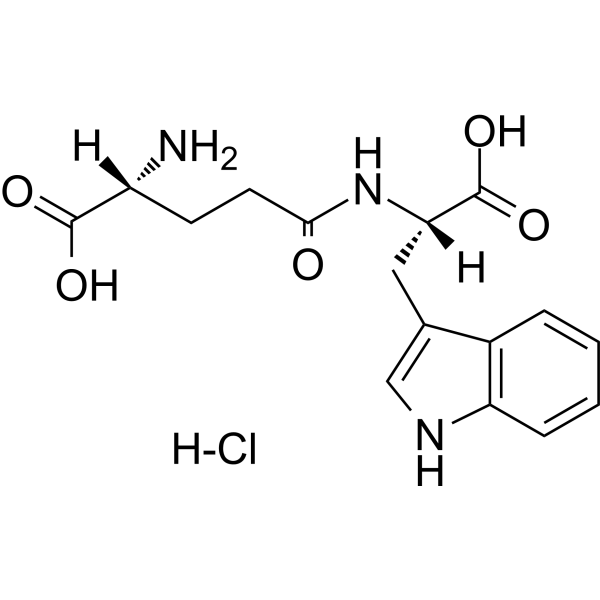
-
- HY-P1409
-
|
|
Potassium Channel
|
Inflammation/Immunology
|
|
ADWX 1 is a new peptide inhibitor that is potent and selective for Kv1.3 with an IC50 value of 1.89 pM. ADWX 1 inhibits Kv1.3 channel activity specifically to inhibit both the initial calcium signaling and NF-κB activation. ADWX 1 ameliorates the disease in rats of experimental autoimmune encephalomyelitis (EAE) models. ADWX 1 can be used to study T cell-mediated autoimmune diseases .
|
-

-
- HY-P2200
-
|
BMY-29304
|
HIV
Antibiotic
|
Infection
Inflammation/Immunology
|
|
Siamycin I (BMY-29304), a 21-residue tricyclic peptide, is a secondary metabolite in actinomycetes. Siamycin I is a HIV fusion inhibitor with ED50s of 0.05 to 5.7 μM for acute HIV type 1 (HIV-1) and HIV-2 infections. Siamycin I inhibits the gelatinase and gelatinase biosynthesis-activating pheromone (GBAP) signaling via the FsrC-FsrA two-component regulatory system in a noncompetitive manner. Siamycin I suppresses the expression of both fsrBDC and gelE-sprE transcripts. Siamycin I, a lasso peptide, interacts with lipid II and inhibits cell wall biosynthesis. Siamycin I, an antibiotic, has the potential for enterococcal infections research .
|
-
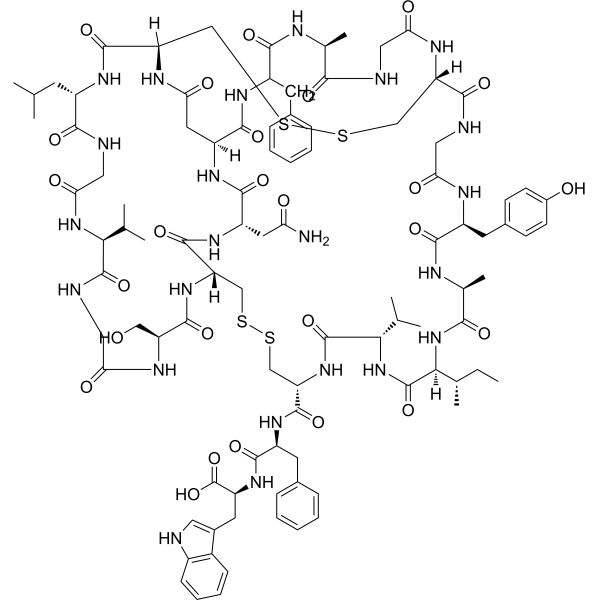
- HY-P5520
-
|
|
Bombesin Receptor
|
Cancer
|
|
GB-6 is a short linear peptide that targets the gastrin releasing peptide receptor (GRPR). GRPR is overexpressed in pancreatic cancer. Based on the tumor selectivity and tumor-specific accumulation properties of GB-6, GB-6 labeled with near infrared (NIR) fluorescent dyes or radionuclide netium-99m (99mTc) can be used as a high-contrast imaging probe. GB-6 has excellent in vivo stability, with tumor to pancreatic and intestinal fluorescence signal ratios of 5.2 and 6.3, respectively, in SW199 0 subcutaneous xenograft models. GB-6 can rapidly target tumors and accurately delineate tumor boundaries, which has broad application prospects .
|
-

- HY-P1416A
-
|
|
Wnt
|
Cancer
|
|
Foxy-5 TFA, a WNT5A agonist, is a mimicking peptide of WNT5A which is a non-canonical member of the Wnt family. Foxy-5 TFA triggers cytosolic free calcium signaling without affecting β-catenin activation and it impairs the migration and invasion of epithelial cancer cells. Foxy-5 TFA effectively reduces the metastatic spread of WNT5A-low prostate cancer cells in an orthotopic mouse model .
|
-
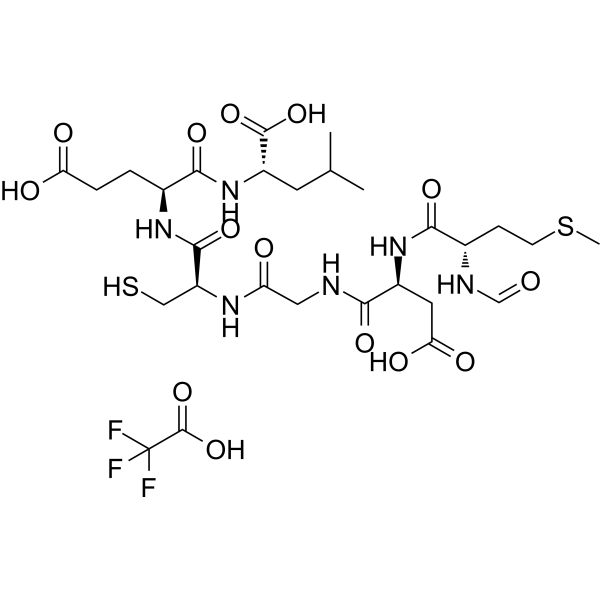
- HY-14743
-
|
SCV 07; Gamma-D-glutamyl-L-tryptophan
|
Bacterial
STAT
|
Infection
Inflammation/Immunology
Cancer
|
|
Golotimod (SCV-07), an immunomodulating peptide with antimicrobial activity, significantly increases the efficacy of antituberculosis therapy, stimulates thymic and splenic cell proliferation, and improves macrophage function. Golotimod (SCV-07) inhibits STAT3 signaling and modulates the duration and severity of oral mucositis in animal models that received radiation or a combination of radiation and Cisplatin. Golotimod (SCV-07) is also a potential therapeutic for recurrent genital herpes simplex virus type 2 (HSV-2) .
|
-
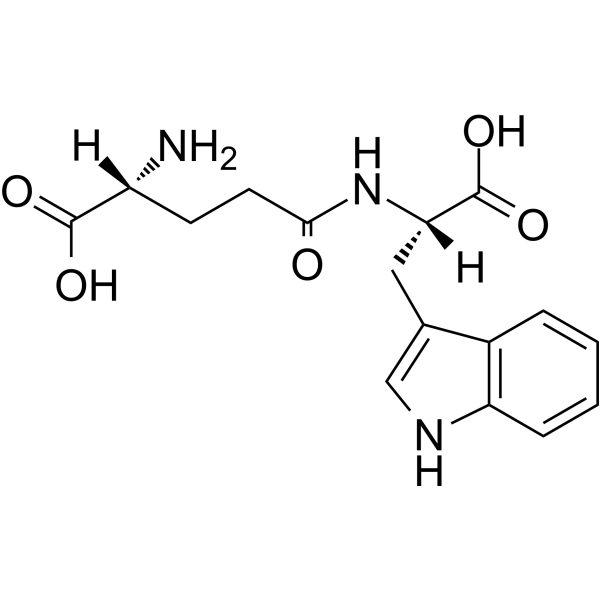
- HY-P1454A
-
|
Ac-LPSDDLEFWCHVMY-NH2 TFA
|
Wnt
|
Cancer
|
|
Fz7-21 (Ac-LPSDDLEFWCHVMY-NH2) TFA is a potent peptide antagonist of FZD7 receptors , selectively binds to FZD7 CRD subclass and alters the conformation of the CRD and the architecture of its lipid-binding groove. The EC50 values are 58 and 34 nM for human and mouse FZD7 CRD, respectively. Fz7-21 TFA impairs the function of FZD7 in Wnt-β-catenin signalling and stem cell function in intestinal organoids .
|
-
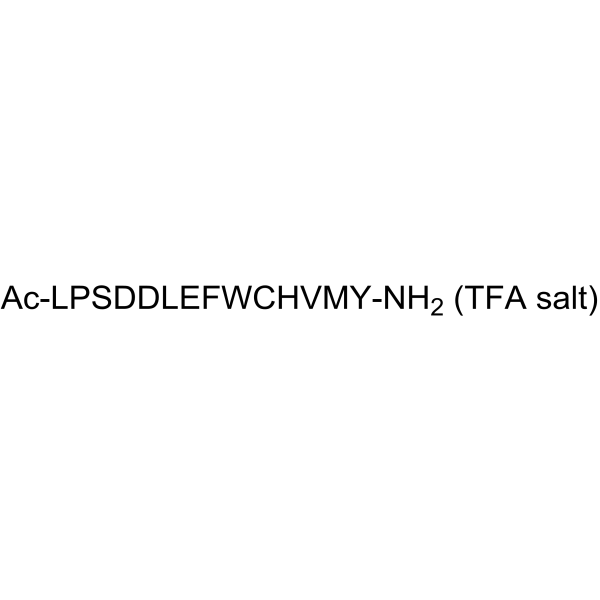
- HY-P5876
-
|
ProADM N20(bovine, porcine); PAMP-20(bovine, porcine)
|
nAChR
|
Neurological Disease
|
|
Proadrenomedullin (N-20) (ProADM N20) (bovine, porcine) is a potent and noncompetitive hypotensive and catecholamine release-inhibitory peptide released from chromaffin cells. Proadrenomedullin (N-20) (bovine, porcine) inhibits catecholamine secretion with an IC50 of 350 nM in PC12 pheochromocytoma cells. Proadrenomedullin (N-20) (bovine, porcine) also blocks (EC50≈270 nM) nicotinic cholinergic agonist desensitization of catecholamine release, as well as desensitization of nicotinic signal transduction ( 22Na + uptake) .
|
-
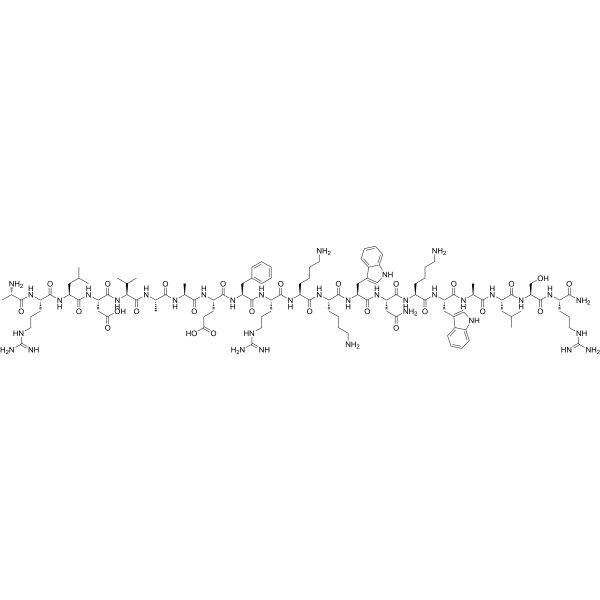
- HY-14743A
-
|
SCV 07 TFA; Gamma-D-glutamyl-L-tryptophan TFA
|
Bacterial
STAT
|
Infection
Inflammation/Immunology
Cancer
|
|
Golotimod TFA (SCV 07 TFA), an immunomodulating peptide with antimicrobial activity, significantly increases the efficacy of antituberculosis therapy, stimulates thymic and splenic cell proliferation, and improves macrophage function. Golotimod TFA (SCV 07 TFA) inhibits STAT3 signaling and modulates the duration and severity of oral mucositis in animal models that received radiation or a combination of radiation and Cisplatin. Golotimod TFA (SCV 07 TFA) is also a potential therapeutic for recurrent genital herpes simplex virus type 2 (HSV-2) .
|
-
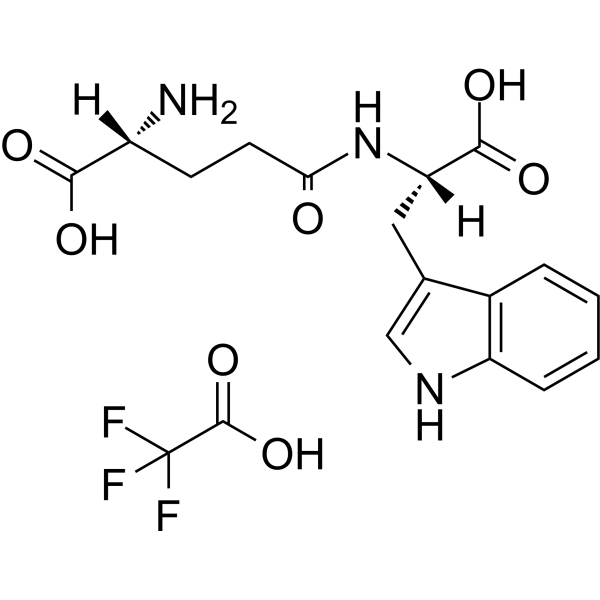
- HY-P5937
-
|
|
Apoptosis
|
Cancer
|
|
Caerin 1.1 TFA is a host defense peptide isolated from the glandular secretions of the Australian tree frog Litoria. Caerin 1.1 TFA inhibits HeLa cell proliferation and mediates apoptosis. Caerin 1.1 TFA may enhance adaptive T cell immune responses .
|
-

- HY-P5357
-
|
|
Protease Activated Receptor (PAR)
|
Others
|
|
SFNGGP-NH2 is a biological active peptide. (PAR-3 is a high-affinity thrombin receptor. PAR-3 mRNA is expressed in the cutaneous mast cells of humans. Protease-Activated Receptors (PARs) have been studied for their roles in itch and their itch-associated response through histamine-dependent/independent pathways have been reported. PAR-3 has been shown not to induce itching alone but possibly in conjunction with PAR-4. Co-expression of PAR-3 and PAR-4 enhances thrombin action suggesting that PAR-3 alone does not mediate transmembrane signaling but instead functions as a cofactor to activate PAR-4.)
|
-
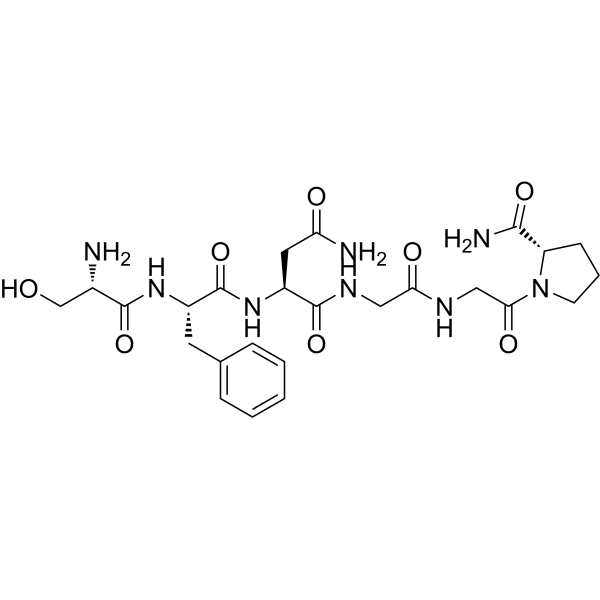
-
-
HY-L033
-
|
|
376 compounds
|
|
Peptidomimetics are compounds whose essential elements (pharmacophore) mimic a natural peptide or protein in 3D space and which retain the ability to interact with the biological target and produce the same biological effect. Peptidomimetics are designed to circumvent some of the problems associated with a natural peptide: e.g. stability against proteolysis (duration of activity) and poor bioavailability. Certain other properties, such as receptor selectivity or potency, often can be substantially improved. The design and synthesis of peptidomimetics are most important because of the dominant position peptide and protein-protein interactions play in molecular recognition and signaling, especially in living systems. Hence mimics have great potential in drug discovery.
MCE Peptidomimetic Library contains 376 compounds including peptoid, α-helix mimetics, β-turn/sheets mimetics, etc. This library is an indispensable tool of structure-activity relationships in drug discovery.
|
| Cat. No. |
Product Name |
Target |
Research Area |
-
- HY-P2522
-
|
|
Bacterial
|
Infection
|
|
Competence-Stimulating Peptide-2 (CSP-2) is a quorum sensing signal peptide produced by Streptococcus pneumoniae. ComD2 is a compatible receptor of Competence-Stimulating Peptide-2 (CSP-2) with an EC50 value of 50.7 nM .
|
-
- HY-P1877A
-
|
|
Peptides
|
Cancer
|
|
SV40 T-Ag-derived NLS peptide TFA is a nuclear localization signal DNA tagged to this peptide efficiently translocates into the cell nucleus .
|
-
- HY-P1877
-
|
|
Peptides
|
Cancer
|
|
SV40 T-Ag-derived NLS peptide is a nuclear localization signal DNA tagged to this peptide efficiently translocates into the cell nucleus .
|
-
- HY-P4872
-
|
|
Peptides
|
Neurological Disease
|
|
Alarin (human) is a hypothalamic neuropeptide belonging to the galanin family of peptides. Alarin (human) has the signal sequence of the GALP precursor peptide and the first 5 aa of the mature GALP .
|
-
- HY-P10087
-
|
Mouse TREM-1(213–221), GF9
|
Peptides
|
Cancer
|
|
Mouse TREM-1 SCHOOL peptide (Mouse TREM-1(213-221), GF9) targets interactions between TREM-1 and its signaling partner DAP-12, and inhibits TREM-1 signaling. Mouse TREM-1 SCHOOL peptide has antitumor effect .
|
-
- HY-P4858
-
|
|
GSK-3
|
Cancer
|
|
C-Peptide 1 (rat), a peptide, is aβ-catenin/GSK-3β activator. C-Peptide 1 (rat) can regulate the Wnt/β-catenin signaling pathway. C-Peptide 1 (rat) can be used for the research of cancer .
|
-
- HY-P3496
-
|
|
Pyroptosis
|
Inflammation/Immunology
|
|
Pep19-2.5 is an synthetic and antitoxin peptide, blocks the intracellular endotoxin signaling cascade. Pep19-2.5 inhibits signaling of lipopeptides (LP) and lipopolysaccharides (LPS) mediated by transmembrane and cytosolic pattern recognition receptors (PRRs). The signaling cascades lead to inflammation and cell pyroptosis .
|
-
- HY-P1111A
-
|
|
Src
Interleukin Related
|
Inflammation/Immunology
|
|
Lyn peptide inhibitor TFA is a potent and cell-permeable inhibitor of Lyn-coupled IL-5 receptor signaling pathway, while keeping other signals intact. Lyn peptide inhibitor TFA blocks Lyn activation and inhibits the binding of Lyn tyrosine kinase to βc subunit of IL-3/GM-CSF/IL-5 receptors. Lyn peptide inhibitor TFA can be used for study of asthma, allergic, and other eosinophilic disorders .
|
-
- HY-P0250
-
-
- HY-P3657A
-
|
|
Fluorescent Dye
|
Cancer
|
|
Biotin-KKKRKV acetate is the biotinylated KKKRKV acetate. KKKRKV is a nuclear localization signal (NLS) peptide derived from simian virus 40 .
|
-
- HY-P10164
-
|
|
Wnt
|
Cancer
|
|
Pen-N3 is a PDZ peptide. Pen-N3 inhibits Wnt/b-catenin signaling by recognizing dishevelled protein .
|
-
- HY-P5239
-
|
|
Peptides
|
Metabolic Disease
|
|
Myristoyl pentapeptide-4 is a bioactive peptide with promotion of hair growth effect and has been reported used as a cosmetic ingredient .
|
-
- HY-P1556
-
|
|
PKG
|
Cardiovascular Disease
|
|
Vasonatrin Peptide (VNP) is a chimera of atrial natriuretic peptide (ANP) and C-type natriuretic peptide (CNP). Vasonatrin peptide possesses the venodilating actions of CNP, the natriuretic actions of ANP, and unique arterial vasodilating actions not associated with either ANP or CNP. Vasonatrin Peptide protects the diabetic heart against ischemia-reperfusion injury by inhibiting ER stress via the cGMP-PKG signaling pathway .
|
-
- HY-P5495
-
|
|
Peptides
|
Others
|
|
Uroguanylin-15 (Rat) is a biological active peptide. (Uroguanylin is a natriuretic peptide, a hormone that regulates sodium excretion by the kidney when excess NaCl is consumed. Uroguanylin and guanylin are related peptides that activate common guanylate cyclase signaling molecules in the intestine and kidney. Uroguanylin was isolated from urine and duodenum but was not detected in extracts from the colon of rats.)
|
-
- HY-P5233
-
|
|
Peptides
|
Others
|
|
Acetyltetrapeptide 11 is a bioactive peptide with anti-aging effect and has been reported used as a cosmetic ingredient .
|
-
- HY-P5251
-
|
|
Peptides
|
Metabolic Disease
|
|
Oligopeptide-68 is a bioactive peptide with anti-aging effect and has been reported used as a cosmetic ingredient .
|
-
- HY-P1556A
-
|
|
PKG
|
Metabolic Disease
|
|
Vasonatrin Peptide (VNP) TFA is a chimera of atrial natriuretic peptide (ANP) and C-type natriuretic peptide (CNP). Vasonatrin peptide TFA possesses the venodilating actions of CNP, the natriuretic actions of ANP, and unique arterial vasodilating actions not associated with either ANP or CNP. Vasonatrin Peptide TFA protects the diabetic heart against ischemia-reperfusion injury by inhibiting ER stress via the cGMP-PKG signaling pathway .
|
-
- HY-P2565
-
-
- HY-P3212
-
|
|
Peptides
|
Cancer
|
|
Allo-aca, a leptin peptidomimetic, is a potent, specific leptin receptor antagonist peptide. Allo-aca blocks leptin signaling and action in numerous in vitro and in vivo models .
|
-
- HY-P5481
-
|
|
Peptides
|
Others
|
|
DABCYL-LPETG-EDANS is a biological active peptide. (This 5-amino acid peptide is a sortase substrate, C-terminal sorting signal. Sortase cleaves surface proteins at the LPXTG motif and catalyzes the formation of an amide bond between the carboxyl group of threonine and the amino group of cell-wall crossbridges. Sortases are a family of Gram-positive transpeptidases responsible for anchoring surface protein virulence factors to the peptidoglycan cell wall layer. Cleavage of this FRET substrate by sortase reveals the fluorescent signal, Abs/Em = 340/490 nm.)
|
-
- HY-107024
-
|
OGP(10-14); Historphin
|
Src
|
Others
|
|
Osteogenic Growth Peptide (10-14) (OGP(10-14)), the C-terminal truncated pentapeptide of osteogenic growth peptide (OGP), retains the full OGP-like activity. Osteogenic Growth Peptide (10-14) is responsible for the binding to the OGP receptor and activates an intracellular Gi-protein-MAP kinase signaling pathway. Osteogenic Growth Peptide (10-14) is a potent mitogen and stimulator of osteogenesis and hematopoiesis. Osteogenic Growth Peptide (10-14) acts as a Src inhibitor .
|
-
- HY-P5323
-
|
|
Peptides
|
Others
|
|
Dabcyl-AGHDAHASET-Edans is a biological active peptide. (This is a type I signal peptidase (SPase1) substrate peptide labeled with EDANS/ DABCYL FRET pair, and contains a crucial cleavage site derived from the C-terminal region of the Staphylococcus epidermidis pre-SceD protein. Abs/Em = 340/490 nm.)
|
-
- HY-P3212A
-
|
|
Peptides
|
Cancer
|
|
Allo-aca TFA, a leptin peptidomimetic, is a potent, specific leptin receptor antagonist peptide. Allo-aca TFA blocks leptin signaling and action in numerous in vitro and in vivo models .
|
-
- HY-P0142
-
|
|
Guanylate Cyclase
|
Inflammation/Immunology
|
|
DT-3 is a membrane-permeable protein kinase G Iα inhibitory peptide. DT-3 is a guanylyl cyclase? inhibitor and shows pharmacological blockade of the cGMP–PKG signalling .
|
-
- HY-P0045
-
|
Matrixyl; Palmitoyl pentapeptide 3; Matrixyl (Palmitoyl Pentapeptide)
|
Peptides
|
Others
|
|
Palmitoyl pentapeptide 4 (Matrixyl; Palmitoyl pentapeptide 3; Matrixyl (Palmitoyl Pentapeptide) is a bioactive peptide with anti-ageing effect and has been reported used as a cosmetic ingredient [1]
|
-
- HY-P1868
-
|
DGEA peptide
|
Integrin
|
Infection
|
|
α2β1 Integrin Ligand Peptide interacts with the α2β1 integrin receptor on the cell membrane and mediates extracellular signals into cells. It is a potential antagonist of collagen receptors .
|
-
- HY-P5435
-
|
|
Peptides
|
Others
|
|
LKBtide is a biological active peptide. (This is a peptide substrate that is phosphorylated by Serine/Threonine kinase 11 (STK11), also known as LKB1. LKBtide is derived from sucrose non-fermenting 1 (SNF1) protein kinase, which is normally activated by the LKB1/AMP-activated protein kinase (AMPK) signaling pathway.)
|
-
- HY-P1868A
-
|
DGEA peptide TFA
|
Integrin
|
Others
|
|
α2β1 Integrin Ligand Peptide TFA interacts with the α2β1 integrin receptor on the cell membrane and mediates extracellular signals into cells. It is a potential antagonist of collagen receptors .
|
-
- HY-P5358
-
|
|
Protease Activated Receptor (PAR)
|
Others
|
|
YFLLRNP is a biological active peptide. (a partial agonist of PAR-1. YFLLRNP selectively active G12/13 signaling pathway without activating Gq or Gi pathways at low concentrations. YFLLRNP (60 μM))
|
-
- HY-P2230
-
|
A6 peptide
|
PAI-1
|
Cancer
|
|
Angstrom6 (A6 Peptide) is an 8 amino-acid peptide derived from single-chain urokinase plasminogen activator (scuPA) and interferes with the uPA/uPAR cascade and abrogates downstream effects. Angstrom6 binds to CD44 resulting in the inhibition of migration, invasion, and metastasis of tumor cells, and the modulation of CD44-mediated cell signaling .
|
-
- HY-P1453
-
|
|
STAT
|
Cancer
|
|
CMD178 is a lead peptide that consistently reduced the expression of Foxp3 and STAT5 induced by IL-2/s IL-2Rα signaling and inhibits Treg cell development .
|
-
- HY-P1453A
-
|
|
STAT
|
Cancer
|
|
CMD178 TFA is a lead peptide that consistently reduced the expression of Foxp3 and STAT5 induced by IL-2/s IL-2Rα signaling and inhibits Treg cell development .
|
-
- HY-P1396
-
-
- HY-P3325
-
|
D-P8RI
|
Peptides
|
Inflammation/Immunology
|
|
P8RI (D-P8RI) is a biomimetic peptide of CD31 and a CD31 agonist. P8RI binds to the juxtamembrane amino acid sequence of the ectodomain of CD31, shows an immunosuppressive effect through restoration of the CD31 inhibitory pathway .
|
-
- HY-P3164
-
|
AcTP1
|
Peptides
|
Others
|
|
Caprooyl-tetrapeptide-9 (AcTP1) is a bioactive peptide with anti-aging effect and has been reported used as a cosmetic ingredient .
|
-
- HY-P5240
-
|
|
Peptides
|
Others
|
|
Acetyl tripeptide-30 citrulline is a bioactive peptide with anti-wrinkle effect and has been reported used as a cosmetic ingredient .
|
-
- HY-P5261
-
|
KP1
|
Peptides
|
Metabolic Disease
|
|
SA1-III(KP1) is a bioactive peptide withanti-agingeffect and has been reported used as a cosmetic ingredient .
|
-
- HY-P10090
-
|
|
Akt
PI3K
Apoptosis
|
Cancer
|
|
Apoptin-derived peptide is an antitumor polypeptide with cytotoxicity. Apoptin-derived peptide promotes apoptosis and necrosis of gastric cancer (GC) cells by regulating PI3K/AKT/ARNT signaling. Apoptin-derived peptide inhibited the invasion and migration of cancer cells, and inhibited the expression and phosphorylation of the subunit p85 of PI3K, which further inhibited the PI3K/AKT pathway involved in the development of gastric cancer .
|
-
- HY-P1803
-
|
PKCε; PRKCE ; peptide Epsilon
|
Peptides
|
Neurological Disease
Inflammation/Immunology
Endocrinology
|
|
Protein Kinase C Peptide Substrate is targeted to a specific cellular compartment in a manner dependent on second messengers and on specific adapter proteins in response to extracellular signals that activate G-protein-coupled receptors, tyrosine kinase receptors, or tyrosine kinase-coupled receptors. Protein Kinase C Peptide Substrate then regulates various physiological functions including the activation of nervous, endocrine, exocrine, inflammatory, and immune systems .
|
-
- HY-106275
-
|
Fibrin-derived peptide Bβ15-42
|
Flavivirus
Dengue virus
|
Cardiovascular Disease
|
|
FX-06 (Fibrin-derived peptide Bβ15-42) is a fibrin Bbeta chain-derived peptide. FX-06 binds to VE-cadherin and inhibits leukocyte transmigration and initiates VE-cadherin-mediated signaling. FX-06 can be used in the research of ischemia/reperfusion injury, Dengue shock syndrome (DSS) .
|
-
- HY-P2019
-
|
|
Peptides
|
Neurological Disease
|
|
Levitide is a neurohormone-like peptide, can be isolated from skin secretions of the South African frog Xenopus laevis. Levitide comes from preprolevitide, is 88 residues long and contains contains the levitide peptide at the C terminus (Glu-Gly-Met-Ile-Gly-Thr-Leu-Thr-Ser-Lys-Arg-Ile-Lys-Gln-NH2) and the putative signal sequence at the N terminus .
|
-
- HY-P5513
-
|
|
Peptides
|
Others
|
|
Aquaporin-2 (254-267), pSER261, human is a biological active peptide. (This peptide is a fragment of the human aquaporin-2 (AQP2) phosphorylated at Ser261. Protein phosphorylation plays a key role in vasopressin signaling in renal-collecting duct. Phosphorylation at several AQP2 residues including Ser256 and Ser261, is altered in response to vasopressin. It is possible that both sites are involved in vasopressin-dependent AQP2 trafficking.)
|
-
- HY-P2282
-
|
|
STAT
|
Cancer
|
|
APTSTAT3-9R, a specific STAT3-binding peptide, inhibits STAT3 activation and downstream signaling by specifically blocking STAT3 phosphorylation. APTSTAT3-9R exerts antiproliferative effects and antitumor activity .
|
-
- HY-P2272
-
|
|
Wnt
β-catenin
|
Cancer
|
|
NLS-StAx-h is a selective, cell permeable, stapled peptide Wnt signaling inhibitor with an IC50 of 1.4 μM. NLS-StAx-h efficiently inhibits β-catenin-transcription factor interactions. NLS-StAx-h shows anti-proliferation of cancer cells .
|
-
- HY-P1420
-
|
|
HIF/HIF Prolyl-Hydroxylase
|
Cancer
|
|
TAT-cyclo-CLLFVY is a cyclic peptide inhibitor of HIF-1 heterodimerization that inhibits hypoxia signaling in cancer cells. TAT-cyclo-CLLFVY disrupts HIF-1α/HIF-1β protein-protein interaction with an IC50 of 1.3 μM .
|
-
- HY-P3970
-
|
|
TGF-β Receptor
|
Inflammation/Immunology
|
|
KRFK, a peptide derived from TSP-1, can activate TGF-β. KRFK promotes TGF-β-mediated signaling and its downstream role, independent of thrombospondin (TSP) receptors such as CD47 and CD36. KRFK can be used for chronic ocular surface inflammatory disorders reseach .
|
-
- HY-P1420A
-
|
|
HIF/HIF Prolyl-Hydroxylase
|
Cancer
|
|
TAT-cyclo-CLLFVY TFA is a cyclic peptide inhibitor of HIF-1 heterodimerization that inhibits hypoxia signaling in cancer cells. TAT-cyclo-CLLFVY TFA disrupts HIF-1α/HIF-1β protein-protein interaction with an IC50 of 1.3 μM .
|
-
- HY-P2272A
-
|
|
Wnt
β-catenin
|
Cancer
|
|
NLS-StAx-h TFA is a selective, cell permeable, stapled peptide Wnt signaling inhibitor with an IC50 of 1.4 μM. NLS-StAx-h TFA efficiently inhibits β-catenin-transcription factor interactions. NLS-StAx-h TFA shows anti-proliferation of cancer cells .
|
-
- HY-P3970A
-
|
|
TGF-β Receptor
|
Inflammation/Immunology
|
|
KRFK TFA, a peptide derived from TSP-1, can activate TGF-β. KRFK TFA promotes TGF-β-mediated signaling and its downstream role, independent of thrombospondin (TSP) receptors such as CD47 and CD36. KRFK TFA can be used for chronic ocular surface inflammatory disorders reseach .
|
-
- HY-P1812
-
|
NP-12
|
PD-1/PD-L1
|
Cancer
|
|
AUNP-12 (NP-12) is a peptide antagonist of the PD-1 signaling pathway, displays equipotent antagonism toward PD-L1 and PD-L2 in rescue of lymphocyte proliferation and effector functions. AUNP-12 exhibits immune activation, excellent antitumor activity, and potential for better management of immune-related adverse events (irAEs) .
|
- HY-P3828
-
|
|
Fluorescent Dye
|
Neurological Disease
|
|
Biotin-myelin basic protein (94-102) is a peptide fragemt. Myelin basic protein is responsible for adhesion of the cytosolic surfaces of multilayered compact myelin, it plays an important role in the process of myelination of nerves in the nervous system. Myelin basic protein also acts as a membrane actin-binding protein, which might allow it to participate in transmission of extracellular signals to the cytoskeleton in oligodendrocytes and tight junctions in myelin .
|
- HY-P3971
-
|
|
TGF-beta/Smad
|
Inflammation/Immunology
|
|
H-Leu-Ser-Lys-Leu-OH (LSYL) is a latency-associated peptide at the amino terminus of LAP, with inhibitory effect on TGF-β1 activation. H-Leu-Ser-Lys-Leu-OH, binding with KRFK (HY-P3970), can block the signal transduction of TGF-β1, and prevent the progression of hepatic damage and fibrosis .
|
- HY-P1812A
-
|
NP-12 TFA
|
PD-1/PD-L1
|
Cancer
|
|
AUNP-12 TFA (NP-12 TFA) is a peptide antagonist of the PD-1 signaling pathway, displays equipotent antagonism toward PD-L1 and PD-L2 in rescue of lymphocyte proliferation and effector functions. AUNP-12 TFA exhibits immune activation, excellent antitumor activity, and potential for better management of immune-related adverse events (irAEs) .
|
- HY-P5372
-
|
|
Protease Activated Receptor (PAR)
|
Others
|
|
Ala-parafluoroPhe-Arg-Cha-Cit-Tyr-NH2 is a biological active peptide. (Protease activated receptor 1 (PAR-1) belongs to a subfamily of G-protein coupled receptors and is known to mediate the cellular effects of thrombin. This peptide is a PAR-1 selective agonist displaying a high level of specificity to PAR-1 over PAR-2. The specificity of peptide was evaluated in cell-based calcium signaling assay using HEK293 cells. PAR-1 selective agonists can be used to study PAR-1 activation in vivo. In addition to its varied cellular effects of thrombin, PAR-1 has also been shown to coordinate with PAR-4 and regulate thrombin-induced hepatocellular carcinoma harboring thrombin formation within the tumor environment classified as 'coagulation type'.)
|
- HY-P1135A
-
|
|
Neuropeptide Y Receptor
|
Neurological Disease
|
|
M1145 TFA, a chimeric peptide, is a selective galanin receptor type 2 (GAL2) agonist, with a Ki of 6.55 nM. M1145 TFA shows more than 90-fold higher affinity for GAL2 over GAL1 (Ki=587 nM) and a 76-fold higher affinity over GalR3 (Ki=497 nM). M1145 TFA has an additive effect on the signal transduction of galanin .
|
- HY-P1416
-
|
|
Wnt
|
Cancer
|
|
Foxy-5, a WNT5A agonist, is a mimicking peptide of WNT5A which is a non-canonical member of the Wnt family. Foxy-5 triggers cytosolic free calcium signaling without affecting β-catenin activation and it impairs the migration and invasion of epithelial cancer cells. Foxy-5 effectively reduces the metastatic spread of WNT5A-low prostate cancer cells in an orthotopic mouse model .
|
- HY-P1454
-
Fz7-21
3 Publications Verification
Ac-LPSDDLEFWCHVMY-NH2
|
Wnt
|
Cancer
|
|
Fz7-21 (Ac-LPSDDLEFWCHVMY-NH2) is a potent peptide antagonist of FZD7 receptors , selectively binds to FZD7 CRD subclass and alters the conformation of the CRD and the architecture of its lipid-binding groove. The EC50 values are 58 and 34 nM for human and mouse FZD7 CRD, respectively. Fz7-21 impairs the function of FZD7 in Wnt–β-catenin signalling and stem cell function in intestinal organoids .
|
- HY-P1409
-
|
|
Potassium Channel
|
Inflammation/Immunology
|
|
ADWX 1 is a new peptide inhibitor that is potent and selective for Kv1.3 with an IC50 value of 1.89 pM. ADWX 1 inhibits Kv1.3 channel activity specifically to inhibit both the initial calcium signaling and NF-κB activation. ADWX 1 ameliorates the disease in rats of experimental autoimmune encephalomyelitis (EAE) models. ADWX 1 can be used to study T cell-mediated autoimmune diseases .
|
- HY-P2200
-
|
BMY-29304
|
HIV
Antibiotic
|
Infection
Inflammation/Immunology
|
|
Siamycin I (BMY-29304), a 21-residue tricyclic peptide, is a secondary metabolite in actinomycetes. Siamycin I is a HIV fusion inhibitor with ED50s of 0.05 to 5.7 μM for acute HIV type 1 (HIV-1) and HIV-2 infections. Siamycin I inhibits the gelatinase and gelatinase biosynthesis-activating pheromone (GBAP) signaling via the FsrC-FsrA two-component regulatory system in a noncompetitive manner. Siamycin I suppresses the expression of both fsrBDC and gelE-sprE transcripts. Siamycin I, a lasso peptide, interacts with lipid II and inhibits cell wall biosynthesis. Siamycin I, an antibiotic, has the potential for enterococcal infections research .
|
- HY-P5520
-
|
|
Bombesin Receptor
|
Cancer
|
|
GB-6 is a short linear peptide that targets the gastrin releasing peptide receptor (GRPR). GRPR is overexpressed in pancreatic cancer. Based on the tumor selectivity and tumor-specific accumulation properties of GB-6, GB-6 labeled with near infrared (NIR) fluorescent dyes or radionuclide netium-99m (99mTc) can be used as a high-contrast imaging probe. GB-6 has excellent in vivo stability, with tumor to pancreatic and intestinal fluorescence signal ratios of 5.2 and 6.3, respectively, in SW199 0 subcutaneous xenograft models. GB-6 can rapidly target tumors and accurately delineate tumor boundaries, which has broad application prospects .
|
- HY-P1416A
-
|
|
Wnt
|
Cancer
|
|
Foxy-5 TFA, a WNT5A agonist, is a mimicking peptide of WNT5A which is a non-canonical member of the Wnt family. Foxy-5 TFA triggers cytosolic free calcium signaling without affecting β-catenin activation and it impairs the migration and invasion of epithelial cancer cells. Foxy-5 TFA effectively reduces the metastatic spread of WNT5A-low prostate cancer cells in an orthotopic mouse model .
|
- HY-14743
-
|
SCV 07; Gamma-D-glutamyl-L-tryptophan
|
Bacterial
STAT
|
Infection
Inflammation/Immunology
Cancer
|
|
Golotimod (SCV-07), an immunomodulating peptide with antimicrobial activity, significantly increases the efficacy of antituberculosis therapy, stimulates thymic and splenic cell proliferation, and improves macrophage function. Golotimod (SCV-07) inhibits STAT3 signaling and modulates the duration and severity of oral mucositis in animal models that received radiation or a combination of radiation and Cisplatin. Golotimod (SCV-07) is also a potential therapeutic for recurrent genital herpes simplex virus type 2 (HSV-2) .
|
- HY-P1454A
-
|
Ac-LPSDDLEFWCHVMY-NH2 TFA
|
Wnt
|
Cancer
|
|
Fz7-21 (Ac-LPSDDLEFWCHVMY-NH2) TFA is a potent peptide antagonist of FZD7 receptors , selectively binds to FZD7 CRD subclass and alters the conformation of the CRD and the architecture of its lipid-binding groove. The EC50 values are 58 and 34 nM for human and mouse FZD7 CRD, respectively. Fz7-21 TFA impairs the function of FZD7 in Wnt-β-catenin signalling and stem cell function in intestinal organoids .
|
- HY-P5876
-
|
ProADM N20(bovine, porcine); PAMP-20(bovine, porcine)
|
nAChR
|
Neurological Disease
|
|
Proadrenomedullin (N-20) (ProADM N20) (bovine, porcine) is a potent and noncompetitive hypotensive and catecholamine release-inhibitory peptide released from chromaffin cells. Proadrenomedullin (N-20) (bovine, porcine) inhibits catecholamine secretion with an IC50 of 350 nM in PC12 pheochromocytoma cells. Proadrenomedullin (N-20) (bovine, porcine) also blocks (EC50≈270 nM) nicotinic cholinergic agonist desensitization of catecholamine release, as well as desensitization of nicotinic signal transduction ( 22Na + uptake) .
|
- HY-P5937
-
|
|
Apoptosis
|
Cancer
|
|
Caerin 1.1 TFA is a host defense peptide isolated from the glandular secretions of the Australian tree frog Litoria. Caerin 1.1 TFA inhibits HeLa cell proliferation and mediates apoptosis. Caerin 1.1 TFA may enhance adaptive T cell immune responses .
|
- HY-P5357
-
|
|
Protease Activated Receptor (PAR)
|
Others
|
|
SFNGGP-NH2 is a biological active peptide. (PAR-3 is a high-affinity thrombin receptor. PAR-3 mRNA is expressed in the cutaneous mast cells of humans. Protease-Activated Receptors (PARs) have been studied for their roles in itch and their itch-associated response through histamine-dependent/independent pathways have been reported. PAR-3 has been shown not to induce itching alone but possibly in conjunction with PAR-4. Co-expression of PAR-3 and PAR-4 enhances thrombin action suggesting that PAR-3 alone does not mediate transmembrane signaling but instead functions as a cofactor to activate PAR-4.)
|
| Cat. No. |
Product Name |
Category |
Target |
Chemical Structure |
Your information is safe with us. * Required Fields.
Inquiry Information
- Product Name:
- Cat. No.:
- Quantity:
- MCE Japan Authorized Agent:


































































